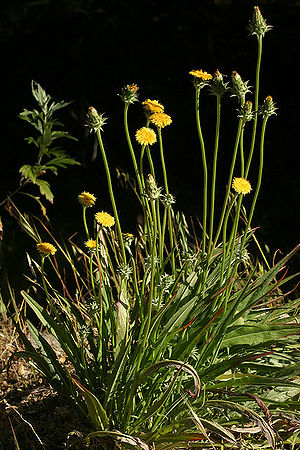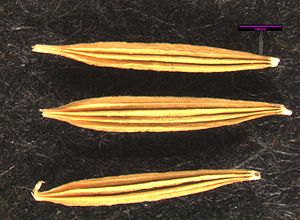Difference between revisions of "Agoseris grandiflora"
| Line 1: | Line 1: | ||
'''''Agoseris grandiflora''''', commonly known as bigflower agoseris, grassland agoseris, or sometimes California dandelion, is a flowering plant in the Asteracae family. | '''''Agoseris grandiflora''''', commonly known as bigflower agoseris, grassland agoseris, or sometimes California dandelion, is a flowering plant in the Asteracae family. | ||
| − | <br>'''Synonyms:''' *''Agoseris laciniata'' '' | + | <br><br>'''Synonyms:''' |
| + | *''Agoseris laciniata'' | ||
| + | *''Stylopappus grandiflorus'' | ||
| + | *''Agoseris cinerea'' | ||
*''Agoseris grandiflora (Nutt.) Greene var. intermedia'' | *''Agoseris grandiflora (Nutt.) Greene var. intermedia'' | ||
*''Agoseris grandiflora (Nutt.) Greene var. plebeia'' | *''Agoseris grandiflora (Nutt.) Greene var. plebeia'' | ||
| Line 23: | Line 26: | ||
*Species Agoseris grandiflora (Nutt.) Greene – bigflower agoseris | *Species Agoseris grandiflora (Nutt.) Greene – bigflower agoseris | ||
===Description=== | ===Description=== | ||
| − | Scapose, stout perennial, 2-7 dm. tall, somewhat hairy when young, the juice milky, with basal, oblanceolate to broadly linear pinnatifid leaves (10-25 cm. long and 1-3 cm. wide. Large flower head with many yellow flowers, involucre 1.5-4 cm. high, its outer bracts broad and short, the inner narrower and elongate; corollas all ligulate. Produces fruits with achene body 4-7 mm. long, tapering to a slender beak 2-4 times as long. http://biology.burke.washington.edu/herbarium/imagecollection.php | + | Scapose, stout perennial, 2-7 dm. tall, somewhat hairy when young, the juice milky, with basal, oblanceolate to broadly linear pinnatifid leaves (10-25 cm. long and 1-3 cm. wide. Large flower head with many yellow flowers, involucre 1.5-4 cm. high, its outer bracts broad and short, the inner narrower and elongate; corollas all ligulate. Produces fruits with achene body 4-7 mm. long, tapering to a slender beak 2-4 times as long. <ref name="UW">[http://biology.burke.washington.edu/herbarium/imagecollection.php WTU Plants Profiles]</ref> |
===Bloom Period=== | ===Bloom Period=== | ||
| − | May-August | + | May-August <ref name="UW"> |
===Distribution=== | ===Distribution=== | ||
| − | West of the Rocky Mountains http://plants.usda.gov/java/profile?symbol=AGGR | + | West of the Rocky Mountains <ref name="USDA">[http://plants.usda.gov/java/profile?symbol=AGGR USDA Plants Profile for Agoseris grandiflora]</ref> |
===Habitat=== | ===Habitat=== | ||
Meadows and other open places in the lowlands and at moderate elevations in the mountains, often in dry areas. http://biology.burke.washington.edu/herbarium/imagecollection.php | Meadows and other open places in the lowlands and at moderate elevations in the mountains, often in dry areas. http://biology.burke.washington.edu/herbarium/imagecollection.php | ||
| Line 34: | Line 37: | ||
===Propagation=== | ===Propagation=== | ||
===Photo Gallery=== | ===Photo Gallery=== | ||
| − | |||
| − | + | ||
| + | ==Seed== | ||
[[File:Agoseris grandiflora.jpg|300px|right|thumb|''Agoseris grandiflora'']] | [[File:Agoseris grandiflora.jpg|300px|right|thumb|''Agoseris grandiflora'']] | ||
| Line 66: | Line 69: | ||
{{Basics}} | {{Basics}} | ||
| + | |||
| + | ===References=== | ||
| + | <References/> | ||
Revision as of 12:10, 23 April 2012
Agoseris grandiflora, commonly known as bigflower agoseris, grassland agoseris, or sometimes California dandelion, is a flowering plant in the Asteracae family.
Synonyms:
- Agoseris laciniata
- Stylopappus grandiflorus
- Agoseris cinerea
- Agoseris grandiflora (Nutt.) Greene var. intermedia
- Agoseris grandiflora (Nutt.) Greene var. plebeia
- Agoseris intermedia
- Agoseris laciniata
- Agoseris marshallii
- Agoseris obtusifolia
- Agoseris plebeia
- Stylopappus grandiflorus Nutt.[1]
Contents
Taxonomy
- Kingdom Plantae – Plants
- Subkingdom Tracheobionta – Vascular plants
- Superdivision Spermatophyta – Seed plants
- Division Magnoliophyta – Flowering plants
- Class Magnoliopsida – Dicotyledons
- Subclass Asteridae
- Order Asterales
- Family Asteraceae – Aster family
- Genus Agoseris Raf. – agoseris
- Species Agoseris grandiflora (Nutt.) Greene – bigflower agoseris
Description
Scapose, stout perennial, 2-7 dm. tall, somewhat hairy when young, the juice milky, with basal, oblanceolate to broadly linear pinnatifid leaves (10-25 cm. long and 1-3 cm. wide. Large flower head with many yellow flowers, involucre 1.5-4 cm. high, its outer bracts broad and short, the inner narrower and elongate; corollas all ligulate. Produces fruits with achene body 4-7 mm. long, tapering to a slender beak 2-4 times as long. [2]
Bloom Period
May-August Cite error: Closing </ref> missing for <ref> tag
Habitat
Meadows and other open places in the lowlands and at moderate elevations in the mountains, often in dry areas. http://biology.burke.washington.edu/herbarium/imagecollection.php
Uses
Propagation
Photo Gallery
Seed
Abbreviation: AGGR
Seed sample from: 2010
Average Measurement: 5.2 x 0.7 x 0.7
Measurement Range: L: 4.6 - 6, W: 0.5 - 0.9, D: 0.5 - 0.9
Features
Shape: Seeds tapering to a beak 2-3 times as long as the body of the seed.
Color: Seeds pale brown with white, glossy hilum.
Additional Structures: Pappus white, and downy.
Surface: Seed body deeply longitudinally grooved. Ridges are finely toothed. Seed slightly glossy.
Latitudinal Cross Section: elliptical ![]()
Longitudinal Cross Section: obovate ![]()
Basic Explanations and Assumptions:
The dimensions for the seeds are length x width x depth. The location of the hilum is used as the base of the seed, and the length is measured from hilum to the opposite apex. Where a style is present, the length is measured from the hilum to the bottom of the style. Width is measured at a right angle to the length at the widest part. Depth is measured at a right angle to the intersection of height and width lines.
Measurements included are the mean average for each measurement of ten separate seeds.
All measurements in millimeters unless otherwise noted.


